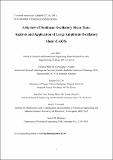| dc.contributor.author | Hyun, Kyu | |
| dc.contributor.author | Wilhelm, Manfred | |
| dc.contributor.author | Klein, Christopher O. | |
| dc.contributor.author | Cho, Kwang Soo | |
| dc.contributor.author | Nam, Jung Gun | |
| dc.contributor.author | Ahn, Kyung Hyun | |
| dc.contributor.author | Lee, Seung Jong | |
| dc.contributor.author | Ewoldt, Randy H. | |
| dc.contributor.author | McKinley, Gareth H. | |
| dc.date.accessioned | 2016-02-19T14:31:00Z | |
| dc.date.available | 2016-02-19T14:31:00Z | |
| dc.date.issued | 2011-03 | |
| dc.date.submitted | 2011-02 | |
| dc.identifier.issn | 00796700 | |
| dc.identifier.uri | http://hdl.handle.net/1721.1/101226 | |
| dc.description.abstract | Dynamic oscillatory shear tests are common in rheology and have been used to investigate a wide range of soft matter and complex fluids including polymer melts and solutions, block copolymers, biological macromolecules, polyelectrolytes, surfactants, suspensions, emulsions and beyond. More specifically, small amplitude oscillatory shear (SAOS) tests have become the canonical method for probing the linear viscoelastic properties of these complex fluids because of the firm theoretical background [1], [2], [3] and [4] and the ease of implementing suitable test protocols. However, in most processing operations the deformations can be large and rapid: it is therefore the nonlinear material properties that control the system response. A full sample characterization thus requires well-defined nonlinear test protocols. Consequently there has been a recent renewal of interest in exploiting large amplitude oscillatory shear (LAOS) tests to investigate and quantify the nonlinear viscoelastic behavior of complex fluids. In terms of the experimental input, both LAOS and SAOS require the user to select appropriate ranges of strain amplitude (γ[subscript 0]) and frequency (ω). However, there is a distinct difference in the analysis of experimental output, i.e. the material response. At sufficiently large strain amplitude, the material response will become nonlinear in LAOS tests and the familiar material functions used to quantify the linear behavior in SAOS tests are no longer sufficient. For example, the definitions of the linear viscoelastic moduli G′(ω) and G″(ω) are based inherently on the assumption that the stress response is purely sinusoidal (linear). However, a nonlinear stress response is not a perfect sinusoid and therefore the viscoelastic moduli are not uniquely defined; other methods are needed for quantifying the nonlinear material response under LAOS deformation. In the present review article, we first summarize the typical nonlinear responses observed with complex fluids under LAOS deformations. We then introduce and critically compare several methods that quantify the nonlinear oscillatory stress response. We illustrate the utility and sensitivity of these protocols by investigating the nonlinear response of various complex fluids over a wide range of frequency and amplitude of deformation, and show that LAOS characterization is a rigorous test for rheological models and advanced quality control. | en_US |
| dc.description.sponsorship | Procter & Gamble Company | en_US |
| dc.description.sponsorship | Schlumberger-Doll Research Center | en_US |
| dc.language.iso | en_US | |
| dc.publisher | Elsevier | en_US |
| dc.relation.isversionof | http://dx.doi.org/10.1016/j.progpolymsci.2011.02.002 | en_US |
| dc.rights | Creative Commons Attribution-Noncommercial-NoDerivatives | en_US |
| dc.rights.uri | http://creativecommons.org/licenses/by-nc-nd/4.0/ | en_US |
| dc.source | MIT Web Domain | en_US |
| dc.title | A review of nonlinear oscillatory shear tests: Analysis and application of large amplitude oscillatory shear (LAOS) | en_US |
| dc.type | Article | en_US |
| dc.identifier.citation | Hyun, Kyu, Manfred Wilhelm, Christopher O. Klein, Kwang Soo Cho, Jung Gun Nam, Kyung Hyun Ahn, Seung Jong Lee, Randy H. Ewoldt, and Gareth H. McKinley. “A Review of Nonlinear Oscillatory Shear Tests: Analysis and Application of Large Amplitude Oscillatory Shear (LAOS).” Progress in Polymer Science 36, no. 12 (December 2011): 1697–1753. | en_US |
| dc.contributor.department | Massachusetts Institute of Technology. Department of Mechanical Engineering | en_US |
| dc.contributor.mitauthor | McKinley, Gareth H. | en_US |
| dc.relation.journal | Progress in Polymer Science | en_US |
| dc.eprint.version | Author's final manuscript | en_US |
| dc.type.uri | http://purl.org/eprint/type/JournalArticle | en_US |
| eprint.status | http://purl.org/eprint/status/PeerReviewed | en_US |
| dspace.orderedauthors | Hyun, Kyu; Wilhelm, Manfred; Klein, Christopher O.; Cho, Kwang Soo; Nam, Jung Gun; Ahn, Kyung Hyun; Lee, Seung Jong; Ewoldt, Randy H.; McKinley, Gareth H. | en_US |
| dc.identifier.orcid | https://orcid.org/0000-0001-8323-2779 | |
| mit.license | PUBLISHER_CC | en_US |
| mit.metadata.status | Complete | |
